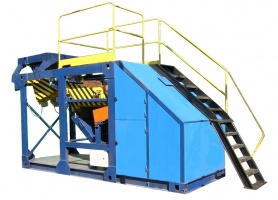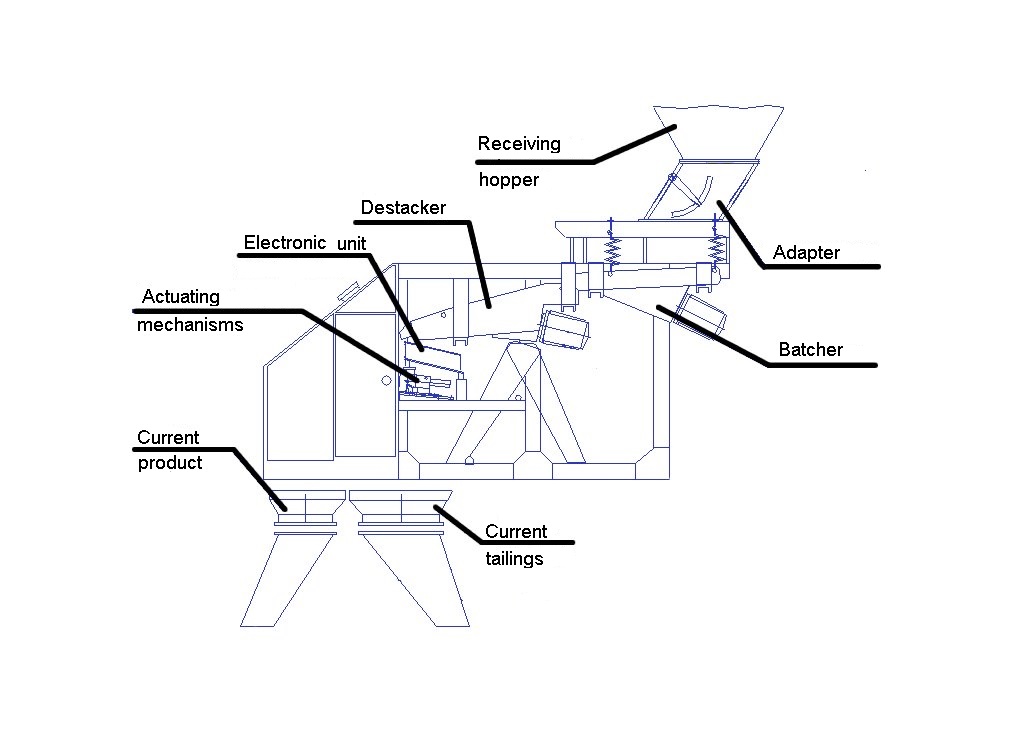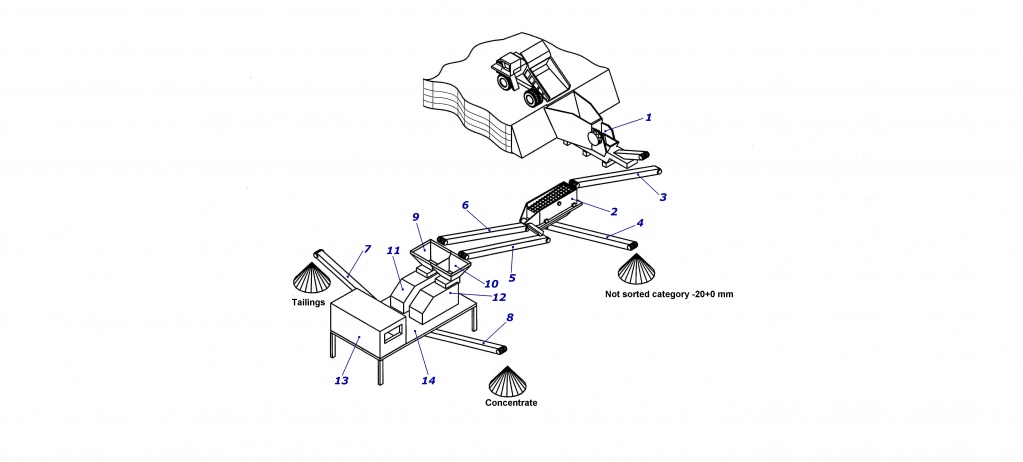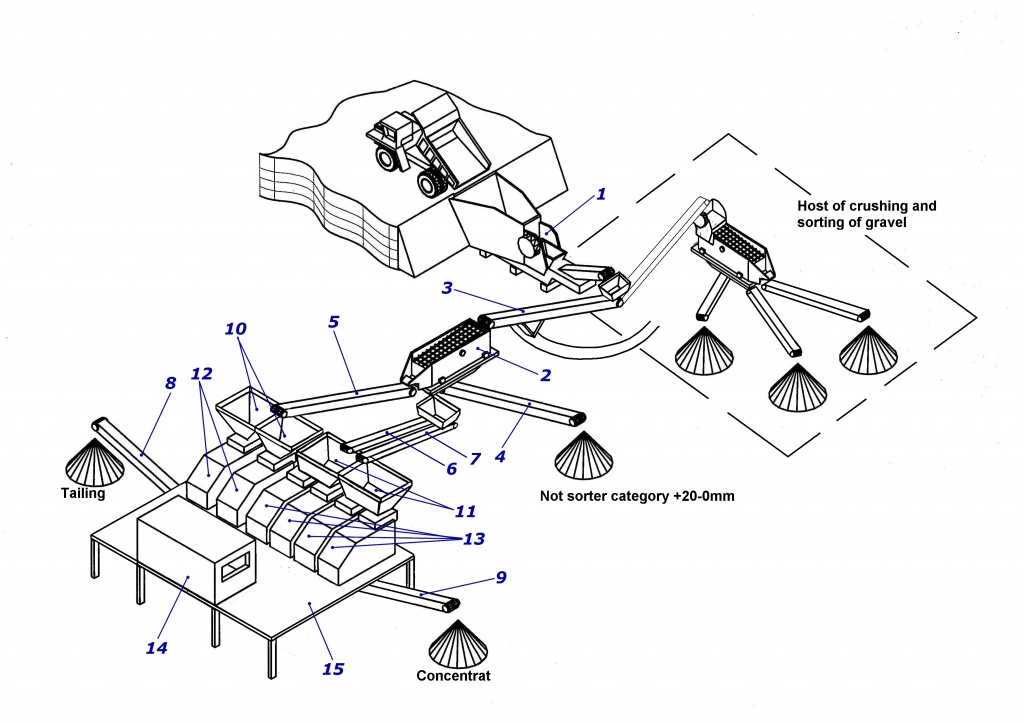- Eng >
- Production >
- Controls quality ore >
- X-ray radiometric sorting
Ore sorter KSF

Ore sorter KSF are used when sorting non-ferrous ores, chenyh and rare metals, gold and silver, platinum, rare earths, ores, tin, tungsten, manganese, chromium, bauxite, quartzite, magnetite, fluorite, nepheline, sillimanite, apatite, coal, metallurgical wastes (slag, linings) and others, the following size fractions: -250 (300) 150 mm 50 mm and -150 -50 20 (10) mm. The operation of this type of equipment is based on X-ray radiometric method (RRM).
Ore sorter
KSF-4-150, KSF-2-300, KSF-3-300
Ore sorter KSF enables to separate the stones containing valuable mineralization from barren stones on the open-pit side. It is designed for:
pre-concentration of low-grade ore;
separation of ore into diverse types followed by its separate treatment in the plant;
production of sellable concentrate;
sorting of slags and wastes of metallurgical industries.
Ore sorter can be applied in precious metal processing (gold, silver, platinum), polymetallic and monomineral ores (cobalt, copper, zinc, lead, tin, antimony, barium, etc), ferrous ores (chromium, manganese, iron), rare metals, diamonds, fluorite, quartzite, sillimanite, magnesite, bauxite, coal; waste and slag of refining factories, aluminum, silicon, copper production, etc.
Ore sorter applies X-ray fluorescence to identifying material composition of individual stones. It is based on processing of the secondary X-ray spectrum detected from the surface of individual stones and processed by the measuring and control system.
Operation of KSF sorter consists in the controlled feeding of stones of a certain size from the storage bin. Then the vibrating feeder drives ore to the vibratory spreader. After that, the stones are distributed among sorting streams in the monolayer and are fed one by one to the analysis-separation area. In the analysis area, an express X-ray fluorescent analysis of the material composition of individual stones is carried out. Then microprocessors of the measuring and control system compare the results with a predetermined threshold and decide whether the stone contains metal values in economically recoverable amounts. The physical separation of stones into two classes of stones (ones that contain metal values and ones that do not) is performed by the actuator according to the signals of the measuring and control system. The monitor of the operator's console displays all the service information about the operation of the hardware and mechanical part, the sorting parameters, and the results of ore grade before and after separation.
The equipment for the ore sorting has been successfully implemented in more than 50 Russian and foreign mineral processing plants.
Based on the results of researching on more than 300 deposits, we found that X-ray ore pre-concentration technology can reject from 15 % to 80% of waste stones from the run-of-mine stream which contains no economic metal values.
The sorting process is dry, low-cost and environmentally harmless. Sorting equipment is mobile and does not require building any capital structures.
Advantages of technology X-ray radiometric sorting
The main advantages of PPC technology are:
- The relative cheapness of implementation process in mines ;
- There is no interference in the current cycle of production (sorting is carried out directly after excavation of ore from the depths , before entering the processing plant );
- Does not require the allocation of large industrial areas (ore sorter are able to work outdoors );
- Relatively low energy consumption ;
- Low operating costs ;
- Ecological purity of the process ;
- Does not require creating a " wet tailings " ( dry process );
- Ease of development and management process;
- The use of sources ( X-ray tubes ) with a "soft" X-rays ( the safety of the service personnel) .
|
Ore sorter KSF technical data |
|||
|
Sorter type |
KSF-4-150 |
KSF-2-300 |
KSF-3-300 |
|
1.Available particle size for ore sorting, mm |
25-150 |
60-300 |
60-300 |
|
2. Particle size ranges, mm |
25-80; |
60-200; |
60-200; |
|
3. Throughput, t/h* (depending on the range) |
10-25 |
20-50 |
20-50 |
|
4. Source of primary X-ray radiation |
Specialized portable X-ray machines |
||
|
5. X-ray detectors |
Detection units based on proportional gas or semiconductor counters |
||
|
6. Actuator type |
Quick-acting electromagnetic gates |
||
|
MI 400 (6-8) |
MI 2 (3-4) |
MI 2 (3-4) |
|
|
7. Number of sorting channels |
4 |
2 |
3 |
|
8. Power supply voltage at AC frequency 50+/- Hz, V |
220/380 |
220/380 |
220/380 |
|
9. Power consumption, kW |
5,0 |
5,0 |
5,0 |
|
10. Overal dimentions, mm 1) ore sorter (lenght x width x height) |
|
|
|
|
11. Weight,kg 1) ore sorter |
|
|
|
* Sorting for three (3) technological product (type)
**Note
Maximum capacity depends on:
-class size and specific gravity of the sorted ore (material);
-quality of the original ore (material) entering the PPC;
-technological requirements for the product and "tails" of sorting.
The optimal value is determined by the performance results of technological tests PPC considering class size sorted material.
Class size range sortable ore (material) may be modified depending on the technological problems with the norm performance is adjusted accordingly.
Principle of operation
Job type Ore sorter KSF based on X-ray radiometric separation criterion.

Figure scheme ore sorter KSF with the names of the basic units
Mineral processing Ore sorter KSF as follows: ore of a hopper enters the transport system , consisting of the feeder and the blocks . On the feeder ore decomposed into a monolayer and served on the guide support , which generates four separate stream. Transport system pokuskovom mode delivers ore measuring area where each piece freefall irradiated with primary X-rays knock electrons out of the particle which K and L series, which are formed HRI ( characteristic X ray) , which is detected by the counters . According to the analysis , a fast system , based on industrial computer , decides triggered actuator , transforming the particular piece in estrus with a rich product (or a failure , then the piece goes into freefall in estrus poor product)
Examples RRS technology

Figure 1: Schematic of circuit devices (with the name of the main equipment).
|
1 - secondary crushing unit SMD-186 (grate); |
|
2 - sorting unit SMD-174A; |
|
3, 4, 5, 6, 7, 8 - conveyors; |
|
9, 10 - receiving hoppers machine classes (50 -150; 20 -50); |
|
11 - Ore sorter 2-200 (1); |
|
12 - Ore sorter KSF 4-150 (2); |
|
13 - Cinematography; |
|
14 - overpass. |

Figure 2: Schematic of circuit devices (with the name of the main equipment)